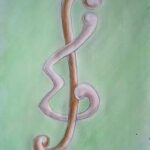
In this paper, we obtain critical sets for the general dihedral group, but we are not able to decide whether they are minimal. We also show the existence of a weakly completable critical set in the latin square based on the dihedral group of order six. We believe this to be the smallest group-based square to have such a set.
An
We investigate those classes
The notion of normal quotient of a vertex-transitive graph was introduced in [5]. It was shown there that many graph properties are inherited by normal quotients. The definition of a normal quotient was given in [5] in group-theoretical terms. In this note we give a combinatorial approximation to this notion which extends the original definition. We show that many of the properties that were inherited by group-theoretical normal quotients are also inherited by combinatorial ones.
A
The toughness
where
In this article, we discuss the toughness of the endline graph of a graph and the middle graph of a graph.
We present several new non-isomorphic one-factorizations of
We prove that all cycles are edge-magic, thus solving a problem presented by [2]. In [3] it was shown that all cycles of odd length are edge-magic. We give explicit constructions that show that all cycles of even length are edge-magic. Our constructions differ for the case of cycles of length
We present results that characterize the covering number and the rank partition of the dual of a matroid
From the results presented it can be seen that every matroid
Let
The star graph
We construct a small table of lower bounds for the maximum number of mutually orthogonal frequency squares of types
A graph
The problem is to determine the number of `cops’ needed to capture a `robber’ where the game is played with perfect information with the cops and the robber alternating moves. The `cops’ capture the `robber’ if one of them occupies the same vertex as the robber at any time in the game. Here we show that a graph with strong isometric dimension two requires no more than two cops.
Combinatorial properties of the multi-peg Tower of Hanoi problem on
in graphs of the multi-peg Tower of Hanoi problem and in this way obtain some combinatorial identities.
A given nonincreasing sequence
It is shown that the necessary conditions are sufficient for the existence of
Let
Let
Let
The niche graph of a digraph
Let
Let
A graph
We reprove an important case of a recent topological result on improved Bonferroni inequalities due to Naiman and Wynn in a purely combinatorial manner. Our statement and proof involves the combinatorial concept of non-evasiveness instead of the topological concept of contractibility. In contradistinction to the proof of Naiman and Wynn, our proof does not require knowledge of simplicial homology theory.
Quackenbush [5] has studied the properties of squags or “Steiner quasigroups”, that is, the corresponding algebra of Steiner triple systems. He has proved that if a finite squag
A plane graph is an embedding of a planar graph into the sphere which may have multiple edges and loops. A face of a plane graph is said to be a pseudo triangle if either the boundary of it has three distinct edges or the boundary of it consists of a loop and a pendant edge. A plane pseudo triangulation is a connected plane graph of which each face is a pseudo triangle. If a plane pseudo triangulation has neither a multiple edge nor a loop, then it is a plane triangulation. As a generalization of the diagonal flip of a plane triangulation, the diagonal flip of a plane pseudo triangulation is naturally defined. In this paper we show that any two plane pseudo triangulations of order
An extended Mendelsohn triple system of order
Special issue: Proceedings of International Conference on Discrete Mathematics (ICDM 2025)
1970-2025 CP (Manitoba, Canada) unless otherwise stated.